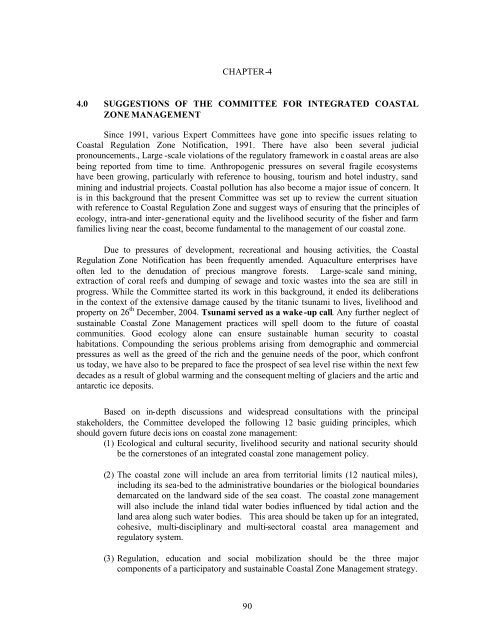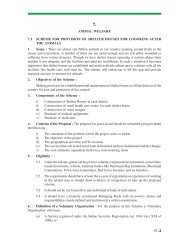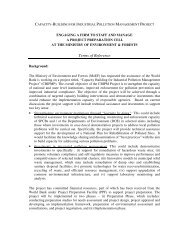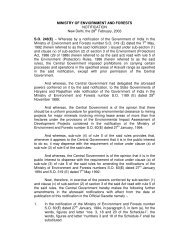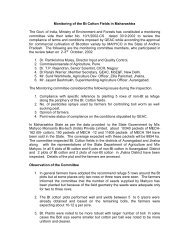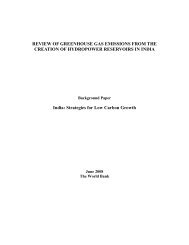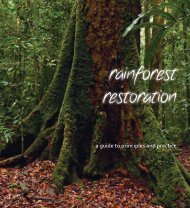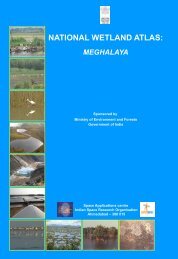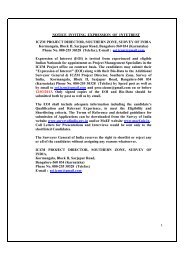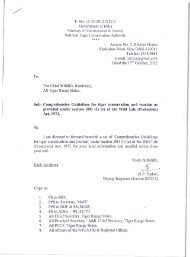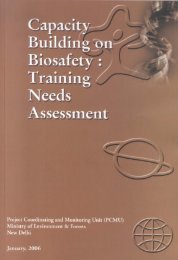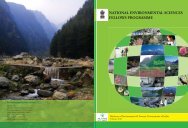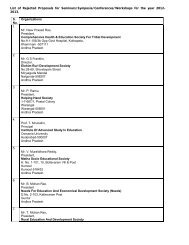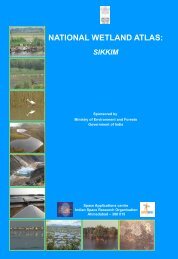pdf - Ministry of Environment and Forests
pdf - Ministry of Environment and Forests
pdf - Ministry of Environment and Forests
- TAGS
- ministry
- forests
- moef.nic.in
Create successful ePaper yourself
Turn your PDF publications into a flip-book with our unique Google optimized e-Paper software.
CHAPTER-4<br />
4.0 SUGGESTIONS OF THE COMMITTEE FOR INTEGRATED COASTAL<br />
ZONE MANAGEMENT<br />
Since 1991, various Expert Committees have gone into specific issues relating to<br />
Coastal Regulation Zone Notification, 1991. There have also been several judicial<br />
pronouncements., Large -scale violations <strong>of</strong> the regulatory framework in c oastal areas are also<br />
being reported from time to time. Anthropogenic pressures on several fragile ecosystems<br />
have been growing, particularly with reference to housing, tourism <strong>and</strong> hotel industry, s<strong>and</strong><br />
mining <strong>and</strong> industrial projects. Coastal pollution has also become a major issue <strong>of</strong> concern. It<br />
is in this background that the present Committee was set up to review the current situation<br />
with reference to Coastal Regulation Zone <strong>and</strong> suggest ways <strong>of</strong> ensuring that the principles <strong>of</strong><br />
ecology, intra-<strong>and</strong> inter-generational equity <strong>and</strong> the livelihood security <strong>of</strong> the fisher <strong>and</strong> farm<br />
families living near the coast, become fundamental to the management <strong>of</strong> our coastal zone.<br />
Due to pressures <strong>of</strong> development, recreational <strong>and</strong> housing activities, the Coastal<br />
Regulation Zone Notification has been frequently amended. Aquaculture enterprises have<br />
<strong>of</strong>ten led to the denudation <strong>of</strong> precious mangrove forests. Large-scale s<strong>and</strong> mining,<br />
extraction <strong>of</strong> coral reefs <strong>and</strong> dumping <strong>of</strong> sewage <strong>and</strong> toxic wastes into the sea are still in<br />
progress. While the Committee started its work in this background, it ended its deliberations<br />
in the context <strong>of</strong> the extensive damage caused by the titanic tsunami to lives, livelihood <strong>and</strong><br />
property on 26 th December, 2004. Tsunami served as a wake -up call. Any further neglect <strong>of</strong><br />
sustainable Coastal Zone Management practices will spell doom to the future <strong>of</strong> coastal<br />
communities. Good ecology alone can ensure sustainable human security to coastal<br />
habitations. Compounding the serious problems arising from demographic <strong>and</strong> commercial<br />
pressures as well as the greed <strong>of</strong> the rich <strong>and</strong> the genuine needs <strong>of</strong> the poor, which confront<br />
us today, we have also to be prepared to face the prospect <strong>of</strong> sea level rise within the next few<br />
decades as a result <strong>of</strong> global warming <strong>and</strong> the consequent melting <strong>of</strong> glaciers <strong>and</strong> the artic <strong>and</strong><br />
antarctic ice deposits.<br />
Based on in-depth discussions <strong>and</strong> widespread consultations with the principal<br />
stakeholders, the Committee developed the following 12 basic guiding principles, which<br />
should govern future decis ions on coastal zone management:<br />
(1) Ecological <strong>and</strong> cultural security, livelihood security <strong>and</strong> national security should<br />
be the cornerstones <strong>of</strong> an integrated coastal zone management policy.<br />
(2) The coastal zone will include an area from territorial limits (12 nautical miles),<br />
including its sea-bed to the administrative boundaries or the biological boundaries<br />
demarcated on the l<strong>and</strong>ward side <strong>of</strong> the sea coast. The coastal zone management<br />
will also include the inl<strong>and</strong> tidal water bodies influenced by tidal action <strong>and</strong> the<br />
l<strong>and</strong> area along such water bodies. This area should be taken up for an integrated,<br />
cohesive, multi-disciplinary <strong>and</strong> multi-sectoral coastal area management <strong>and</strong><br />
regulatory system.<br />
(3) Regulation, education <strong>and</strong> social mobilization should be the three major<br />
components <strong>of</strong> a participatory <strong>and</strong> sustainable Coastal Zone Management strategy.<br />
90


